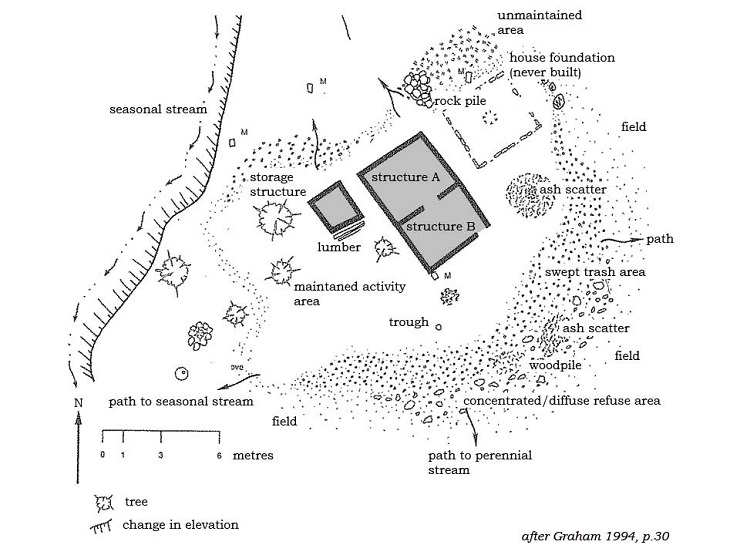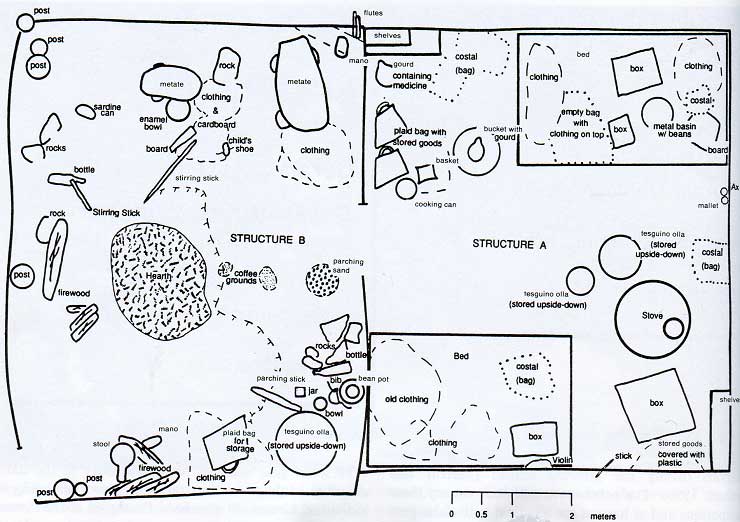An interesting combination of farming and nomadic economy based on seasonal migration led to the creation of the Rarámuri (Tarahumara) society in the northwest of Mexico, the settlement pattern of which was studied by the archaeologist Martha Graham.
At least twice a year this agro-pastoral community moved from its summer (in the valley) to its winter settlement (at a higher altitude). Each family actually owned two or three houses in different ecological zones, in which they lived during different seasons. Their main dwelling was the summer house, in which they lived for most of the year. Conversely, the winter house was inhabited seasonally, only for a period of two to three months. It might be located beneath a rock overhang or in another protected area. The third type of dwelling was a farmhouse located in a field, which was used only for a few days or weeks during several intervals in the course of the year. Unlike the summer and the winter houses not every household had to own it. Based on their frequent moving about, the Rarámuri did not create permanent areas for their activities; in fact, on the contrary, they developed a flexible kind of use of space.
 |
| Plan of the residence of the Rarámuri mobile farmers. |
In the course of their seasonal movements the vast majority of their domestic equipment was left in their homes - every family owned duplicates of the items that they needed for food preparation and for cooking. Stocks of foods and seeds were stored only in one place; either in the main (summer) house or in the farmhouse. Thereby, an adequate amount together with other personal belongings could be transmitted from one house to another.
From time to time residents came to the decision that they should abandon the house permanently. These reasons could vary. If the house was going to be permanently abandoned, people took their useful items with them. Those that were damaged and worn out, or heavy and expendable (manual bottom mills, pens for chickens etc.), were left in place, however.
|
|
| The interior of the main house of the Rarámuri people subsequent to its seasonal abandonment in winter 1988. Area A was built of closely adjacent trunks, while Area B was raised by cca. 1.5 m to ensure the increased access of light. The area that was normally designated for specific activities (with beds and in the vicinity of the stove) in an abandoned building served as a storage area for different items. Generally the dishes were left turned upside-down. |
Want to learn more?
- Graham, M. 1993. Settlement organization and resident variability among the Rarámuri. In Abandonment of settlements and regions : ethnoarchaeological and archaeological approaches, eds. C. Cameron, and S. Tomka, 25-42. Cambridge: Cambridge University Press.
- Graham, M. 1994. Mobile Farmers. An Ethnoarchaeological Approach to Settlement Organization among the Rarámuri of Northwestern Mexico. Ann Arbor: International Monographs in Prehistory.
 Archeologické 3D virtuální muzeum
Archeologické 3D virtuální muzeum

.jpg)
